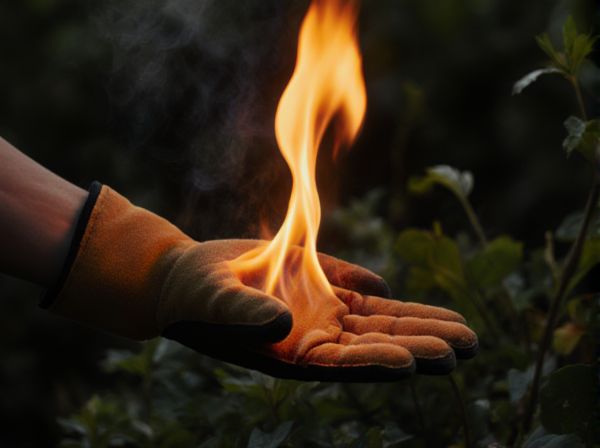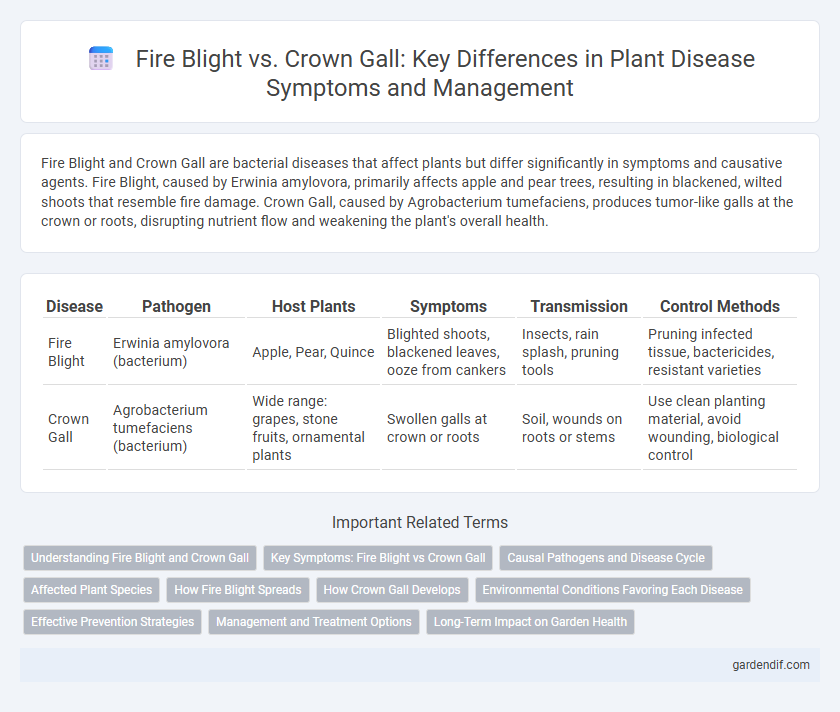
Fire Blight vs Crown Gall Illustration
Fire Blight and Crown Gall are bacterial diseases that affect plants but differ significantly in symptoms and causative agents. Fire Blight, caused by Erwinia amylovora, primarily affects apple and pear trees, resulting in blackened, wilted shoots that resemble fire damage. Crown Gall, caused by Agrobacterium tumefaciens, produces tumor-like galls at the crown or roots, disrupting nutrient flow and weakening the plant's overall health.
Table of Comparison
| Disease | Pathogen | Host Plants | Symptoms | Transmission | Control Methods |
|---|---|---|---|---|---|
| Fire Blight | Erwinia amylovora (bacterium) | Apple, Pear, Quince | Blighted shoots, blackened leaves, ooze from cankers | Insects, rain splash, pruning tools | Pruning infected tissue, bactericides, resistant varieties |
| Crown Gall | Agrobacterium tumefaciens (bacterium) | Wide range: grapes, stone fruits, ornamental plants | Swollen galls at crown or roots | Soil, wounds on roots or stems | Use clean planting material, avoid wounding, biological control |
Understanding Fire Blight and Crown Gall
Fire Blight is a bacterial disease primarily affecting apple and pear trees, caused by Erwinia amylovora, characterized by blackened, wilted shoots and oozing cankers. Crown Gall, caused by Agrobacterium tumefaciens, leads to tumor-like galls at the crown or roots of various woody plants, disrupting nutrient flow and overall plant vitality. Differentiating these diseases through symptoms and causal agents is crucial for effective management and prevention strategies in orchards and nurseries.
Key Symptoms: Fire Blight vs Crown Gall
Fire blight primarily causes blackening and wilting of blossoms, shoots, and branches, often with a characteristic shepherd's crook appearance at the tips. Crown gall presents as rough, tumor-like galls on roots and lower stems, disrupting nutrient flow and weakening the affected plants. Differentiating these symptoms is crucial for accurate diagnosis and effective management of infected trees and shrubs.
Causal Pathogens and Disease Cycle
Fire Blight is caused by the bacterium Erwinia amylovora, which infects plants primarily through blossoms, shoots, and wounds, proliferating rapidly in warm, humid conditions and spreading via rain, insects, and contaminated tools. Crown Gall results from infection by Agrobacterium tumefaciens, a soilborne bacterium that enters through wounds on roots or lower stems, inducing tumor-like galls that disrupt nutrient flow and persist in the soil, enabling repeated infections. Both diseases exhibit distinct disease cycles, with Fire Blight's cycle revolving around seasonal blossom infections and rapid symptom progression, while Crown Gall's cycle involves long-term persistence in soil and woody tissue, causing chronic damage.
Affected Plant Species
Fire blight primarily affects apple and pear trees, causing severe damage to blossoms, shoots, and branches, while Crown Gall targets a wider range of woody and herbaceous plants, including grapes, roses, and stone fruits. Fire blight is caused by the bacterium Erwinia amylovora, which infects members of the Rosaceae family, whereas Crown Gall is caused by Agrobacterium tumefaciens, which induces tumor-like galls on the roots and stems of many dicotyledonous plants. Understanding the specific host range is critical for effective disease management and prevention strategies in affected orchards and vineyards.
How Fire Blight Spreads
Fire Blight spreads primarily through bacterial ooze that infects blossoms, shoots, and branches during warm, wet conditions, facilitated by insects, rain splash, and pruning tools. The pathogen Erwinia amylovora enters plants via natural openings or wounds, rapidly moving through vascular tissues. This airborne and contact transmission makes early detection and sanitation crucial to prevent widespread orchard damage.
How Crown Gall Develops
Crown Gall develops when the bacterium Agrobacterium tumefaciens infects plant wounds, transferring a segment of its DNA into the host genome, causing uncontrolled cell division and tumor-like growths called galls. These galls commonly form at the crown, roots, and sometimes branches, disrupting nutrient and water flow, leading to reduced plant vigor and potential death. Unlike fire blight, which rapidly kills branches and leaves, crown gall causes chronic stress by physically obstructing vascular tissues over time.
Environmental Conditions Favoring Each Disease
Fire Blight thrives in warm, wet environments with temperatures ranging from 18degC to 30degC and high humidity, especially during spring and early summer when blossoms are present. Crown Gall favors poorly drained soils and wounds caused by mechanical injury or insect damage, often proliferating in cool to moderate climates between 20degC and 25degC. Moisture stress and soil compaction exacerbate Crown Gall development, while Fire Blight outbreaks correlate strongly with rainfall during bloom periods.
Effective Prevention Strategies
Fire Blight prevention relies heavily on selecting resistant apple and pear varieties and applying timely bactericides such as copper compounds and streptomycin during bloom. Crown Gall control emphasizes sanitation practices, including removing infected plant material and avoiding mechanical injuries that facilitate Agrobacterium tumefaciens infection. Employing integrated disease management combining cultural practices and targeted chemical treatments significantly reduces the incidence of both bacterial diseases in orchards.
Management and Treatment Options
Effective management of Fire Blight involves timely pruning of infected branches and applying copper-based bactericides or antibiotics such as streptomycin during bloom periods to reduce bacterial populations. Crown Gall control relies heavily on preventing wounds during planting and using biological control agents like Agrobacterium radiobacter strain K84 to inhibit tumor formation. Both diseases benefit from sanitation practices, resistant rootstocks, and monitoring environmental conditions to minimize infection risk.
Long-Term Impact on Garden Health
Fire Blight causes rapid tissue necrosis and can severely weaken apple and pear trees, often leading to branch dieback and reduced fruit yield over several seasons. Crown Gall results in tumor-like growths on roots and stems, disrupting nutrient flow and causing gradual decline, which may persist for years and affect overall plant vitality. Both diseases compromise long-term garden health by diminishing plant vigor and increasing susceptibility to secondary infections.
Fire Blight vs Crown Gall Infographic

 gardendif.com
gardendif.com